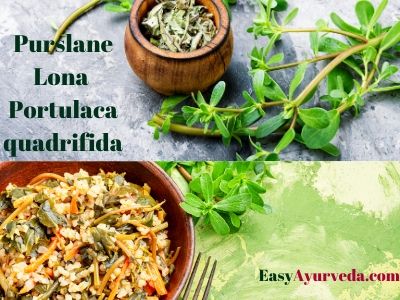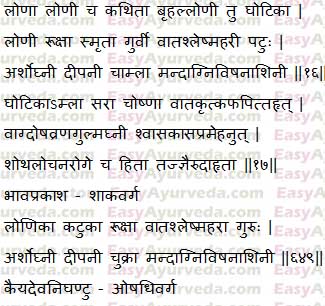Purslane (Lona) – Uses, Qualities, Remedy, Research
By Dr Renita D’Souza
Purslane is widely used as folklore medicine. Its leaves are rich source in omega-3 fatty acids. WHO has given it the term ‘Global Panacea’ and listed under most used medicinal plant. In ancient times it was considered as anti-magic herb and used to protect against evil spirits. It was kept on the bed while sleeping to protect the person from having nightmares.
Read – Spinach (Palak) – Uses, Qualities, Remedies, Research
Table of Contents
Botanical Name
Choti Lona – Portulaca quadrifida
Family – Portulacaceae
Badi Lona – Portulaca oleracea
Family – Portulacaceae

Vernacular Names
English Name – Chickenweed, Wild purslane
Portulaca oleracea – Garden purslane, Verdolaga, Red root, Pursley
Hindi Name – Chotilona, Nonisag, Chotiloniya, Jangliloniya, Khate Chawal, Chounlayi, Nonia
Bigger variety (Portulaca oleracea) – Badi lona, Lonashaaka, Kulpha
Bengali Name – Kshudre nuni, Vannuni
Portulaca oleracea – Badanuni
Marathi Name – Bhui ghola, Lahan ghola
Portulaca oleracea – Ghola
Gujarati Name – Luni
Kannada Name – Goli, Hali Bachchdi Hali Dajjili,Gooni soppu
Telugu Name – Pahal kur, Goddu pavelli
Tamil Name – Koril Kirai, Pasalai keerai, Chinnaparuppukirai, Siru pasalai
Malayalam Name – Neelakeera
Read – Brahmi (Bacopa Monnieri) Benefits, Dose, Side Effects, Research
Varieties
According to Bhavaprakasha Nighantu there are 2 varieties.
1. Loni (choti lona) – small variety
2. Ghotika (badi lona) – bigger variety
Remedies
Portulaca quadrifida (choti lona)
- Fresh leaves juice is applied externally as a remedy for herpes (visarpa)
- Hot infusion is used in dysuria (mutrakrichra)
- Seeds are used as vermicide
Portulaca oleracea (Badi lona)
- Its juice is used as remedy in all types of bleeding diseases and fever
- It is used as vegetable in piles
- Its paste is applied as poultice in herpes, swelling, wound, burning sensation etc. It relieves burning and swelling.
- In Inflammation related to kidney and urinary bladder, plant is prepared into a dish and consumed.
- The dried aerial part of the plant is used in dose of 9 – 15 grams, to treat fever, dysentery, diarrhea, carbuncle, eczema and passage of blood through anus.
- Aqueous extracts of the plant possess muscle relaxing effects.
- The fresh juice is used in the treatment of strangury ( slow and painful spasmodic discharge of urine drop by drop), coughs, sores etc
- Its leaves tea is used a remedy for stomach ache as and headache.
- For earache its leaf juice is applied.(C)
Sanskrit Verse

Medicinal Qualities
Choti Lona
Taste – Salty, Sour; Pungent (K.N)
Ruksha – dry in nature
Guru – heavy to digest
Deepana – kindles digestive fire
Effect on tridoshas
Balances vata and kapha dosha
Badi lona (Ghotika)
Taste – sour
Sara – causes mobility
Potency (virya) – hot
Effect on Tridoshas
Increases vata dosha
Decreases kapha and pitta dosha
Uses
Choti Lona (loni)
Arshas – piles
Mandaagni – low digestive fire
Vishanaashini – poisoning
Badi lona (Ghotika)
Vak dosha – speech problems
Vrana – wound, ulcer
Gulma – abdominal tumor
Shwasa – asthma
Kasa – cough
Prameha – diabetes
Shota – inflammation
Lochana roga – eye disorders
Read – Gotu Kola Health Benefits, Uses, Dose, Side Effects
Interaction with medicines, supplements
Can this be used while taking Homeopathic medicine?
Yes. This product does not react with homeopathic medicine.
Can
this medicine be continued while taking supplements like multivitamin tablets,
Omega 3 fatty acids etc?
Yes. Generally, this product goes well with most
of the dietary supplements. However, if you are taking more than one product
per day, please consult your doctor for an opinion.
With western
medicines
Seek your
doctor’s advice if you are taking this product along with other western
(allopathic / modern) medicines. Some Ayurvedic herbs can interact with modern
medicine.
If both Ayurvedic and allopathic medicines are advised together, then it is
best to take Allopathic medicine first, wait for 30 minutes and then take the
Ayurvedic medicine.
Pharmacological Activities
Potulaca quadrifida possesses diuretic, febrifuge, vermifuge, antiseptic, anti-spasmodic, analgesic, anti-bacterial, skeletal muscle-relaxant, wound- healing, anti-inflammatory, radical scavenger and anti-convulsant (A)
Portulaca oleracea possesses neuroprotective, antimicrobial, anti-diabetic, antioxidant, anti-inflammatory, antiulcerogenic and anticancer activities (B)
Phytochemicals
Portulaca oleracea, such as flavonoids, alkaloids, polysaccharides, fatty acids, terpenoids, sterols, proteins vitamins and minerals.
Morphology, Distribution
Morphology
Potulaca quadrifida is an annual herb. Spreading, much branched stem, rooting at the nodes. Leaves are opposite, simple, succulent, sessile, ovate-elliptic and smooth. Flowers are yellow in color with 4 petals and 8-10 stamens. Fruit an obovoid capsule, 2–3.5 mm long containing many seeds.
Distribution
Potulaca quadrifida is widely distributed in Africa and tropical Asia.
Research
Omega-3 Fatty Acid and Antioxidant Property – A research study conducted on nutrition, Omega-3 Fatty Acid and Antioxidant Property of Purslane (Portulaca oleracea L.) have proved that it is a potential source of Omega-3 Fatty Acid and Antioxidant.
Sanskrit Synonyms
Lona, loni
Bigger variety – Bruhaloni, Ghotika
Categorization
Classical Categorization
Bhavaprakasha Nighantu – Shakavarga
Kaiyadeva Nighantu – Aushadhi varga
Scientific Classification
Kingdom – Plantae
Phylum – Spermatophyta
Subphylum – Angiospermae
Class – Dicotyledonae
Order – Caryophyllales
Family – Portulacaceae
Genus – Portulaca
Species – Portulaca oleracea
Click to Consult Dr Renita D’Souza










